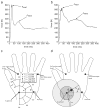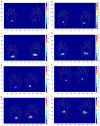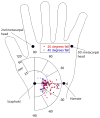Pressure distribution over the palm region during forward falls on the outstretched hands
- PMID: 21035120
- PMCID: PMC3471983
- DOI: 10.1016/j.jbiomech.2010.09.011
Pressure distribution over the palm region during forward falls on the outstretched hands
Abstract
Falls on the outstretched hands are the cause of over 90% of wrist fractures, yet little is known about bone loading during this event. We tested how the magnitude and distribution of pressure over the palm region during a forward fall is affected by foam padding (simulating a glove) and arm configuration, and by the faller's body mass index (BMI) and thickness of soft tissues over the palm region. Thirteen young women with high (n=7) or low (n=6) BMI participated in a "torso release experiment" that simulated falling on both outstretched hands with the arm inclined either at 20° or 40° from the vertical. Trials were acquired with and without a 5 mm thick foam pad secured to the palm. Outcome variables were the magnitude and location of peak pressure (d, θ) with respect to the scaphoid, total impact force, and integrated force applied to three concentric areas, including "danger zone" of 2.5 cm radius centered at the scaphoid. Soft tissue thickness over the palm was measured by ultrasound. The 5mm foam pad reduced peak pressure, and peak force to the danger zone, by 83% and 13%, respectively. Peak pressure was 77% higher in high BMI when compared with low BMI participants. Soft tissue thickness over the palm correlated positively with distance (d) (R=0.79, p=0.001) and force applied outside the danger zone (R=0.76, p=0.002), but did not correlate with BMI (R=0.43, p=0.14). The location of peak pressure was shunted 4 mm further from the scaphoid at 20° than that of 40° falls (d=25 mm (SD 8), θ=-9° (SD 17) in the 20° falls versus d=21 mm (SD 8), θ=-5° (SD 24) in the 40° falls). Peak force to the entire palm was 11% greater in 20° compared with 40° falls. These results indicate that even a 5 mm thick foam layer protects against wrist injury, by attenuating peak pressure over the palm during forward falls. Increased soft tissue thickness shunts force away from the scaphoid. However, soft tissue thickness is not predicted by BMI, and peak pressures are greater in high individuals than that of low BMI individuals. These results contribute to our understanding of the mechanics and prevention of wrist and hand injuries during falls.
Copyright © 2010 Elsevier Ltd. All rights reserved.
Conflict of interest statement
None of the authors above have any financial or personal relationships with other people or organizations that could inappropriately influence this work, including employment, consultancies, stock ownership, honoraria, paid expert testimony, patent applications/registrations, and grants or other funding.
Figures






Similar articles
-
Effect of hip protectors, falling angle and body mass index on pressure distribution over the hip during simulated falls.Clin Biomech (Bristol). 2010 Jan;25(1):63-9. doi: 10.1016/j.clinbiomech.2009.08.009. Clin Biomech (Bristol). 2010. PMID: 19766363
-
Prediction of upper extremity impact forces during falls on the outstretched hand.J Biomech. 1998 Dec;31(12):1169-76. doi: 10.1016/s0021-9290(98)00137-7. J Biomech. 1998. PMID: 9882050
-
Comparison of force attenuation properties of four different hip protectors under simulated falling conditions in the elderly: an in vitro biomechanical study.Bone. 1999 Aug;25(2):229-35. doi: 10.1016/s8756-3282(99)00154-4. Bone. 1999. PMID: 10456390
-
Etiology and prevention of age-related hip fractures.Bone. 1996 Jan;18(1 Suppl):77S-86S. doi: 10.1016/8756-3282(95)00383-5. Bone. 1996. PMID: 8717551 Review.
-
Biomechanical considerations of hip and spine fractures in osteoporotic bone.Instr Course Lect. 1997;46:431-8. Instr Course Lect. 1997. PMID: 9143985 Review.
Cited by
-
Test-retest reliability of the FALL FIT system for assessing and training protective arm reactions in response to a forward fall.MethodsX. 2022 Apr 16;9:101702. doi: 10.1016/j.mex.2022.101702. eCollection 2022. MethodsX. 2022. PMID: 35518921 Free PMC article.
-
A self-cleaning, mechanically robust membrane for minimizing the foreign body reaction: towards extending the lifetime of sub-Q glucose biosensors.J Mater Sci Mater Med. 2019 Jun 25;30(7):79. doi: 10.1007/s10856-019-6282-2. J Mater Sci Mater Med. 2019. PMID: 31240399 Free PMC article.
-
Effects of hip abductor muscle forces and knee boundary conditions on femoral neck stresses during simulated falls.Osteoporos Int. 2015 Jan;26(1):291-301. doi: 10.1007/s00198-014-2812-4. Epub 2014 Jul 16. Osteoporos Int. 2015. PMID: 25027112
-
Impact forces in backward falls: Subject-specific video-based rigid body simulation of backward falls.Proc Inst Mech Eng H. 2023 Nov;237(11):1275-1286. doi: 10.1177/09544119231207653. Epub 2023 Nov 16. Proc Inst Mech Eng H. 2023. PMID: 37969107 Free PMC article.
-
Morphological risk factors for scaphoid fracture: a case-control study.Eur J Trauma Emerg Surg. 2023 Feb;49(1):133-141. doi: 10.1007/s00068-022-02101-y. Epub 2022 Sep 27. Eur J Trauma Emerg Surg. 2023. PMID: 36166077 Free PMC article.
References
-
- Calais-Germain B. Anatomy of Movement. 1. Eastland Press; Seattle WA: 1993. p. 150.
-
- Chiu J, Robinovitch SN. Prediction of upper extremity impact forces during falls on the outstretched hand. Journal of Biomechanics. 1998;31 (12):1169–1176. - PubMed
-
- Choi WJ, Hoffer JA, Robinovitch SN. Effect of hip protectors, falling angle and body mass index on pressure distribution over the hip during simulated falls. Clinical Biomechanics. 2010;25 (1):63–69. - PubMed

